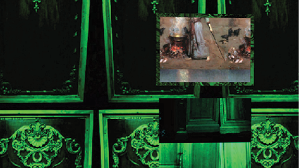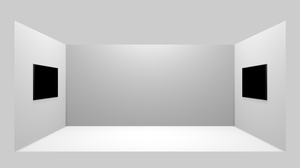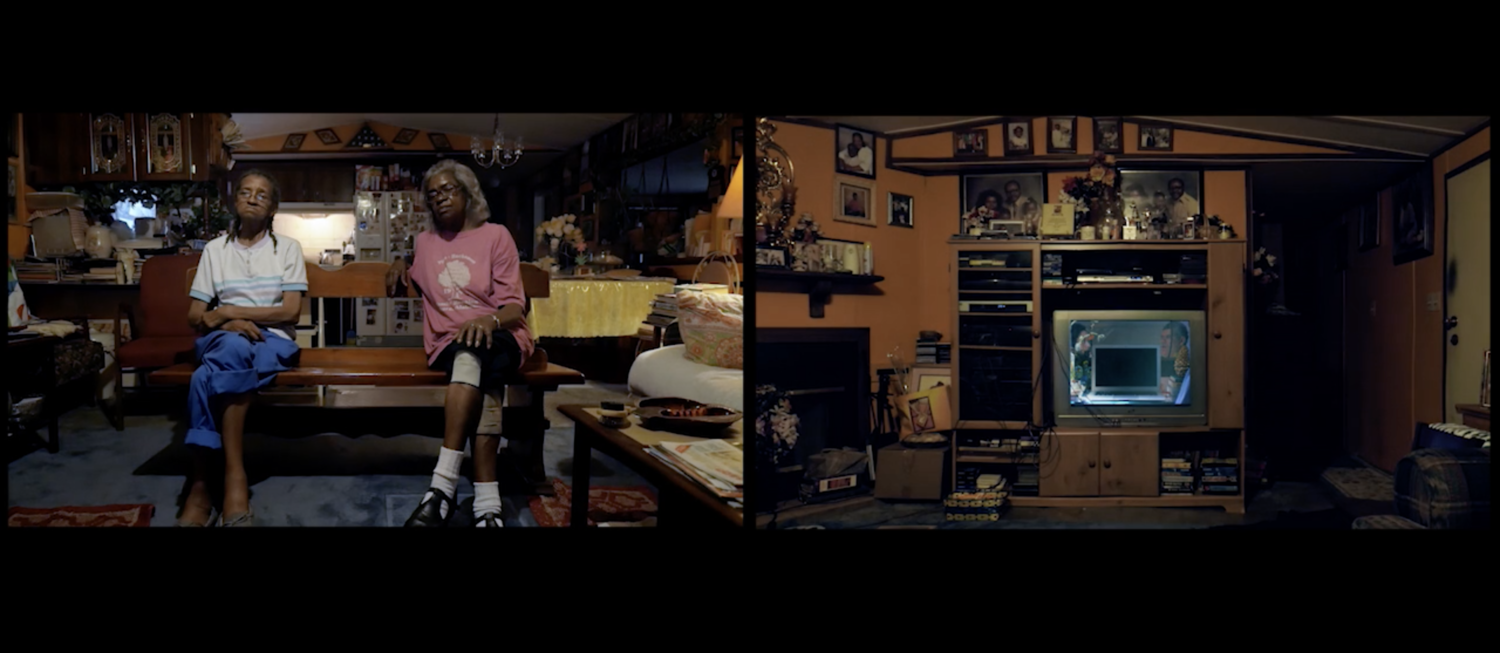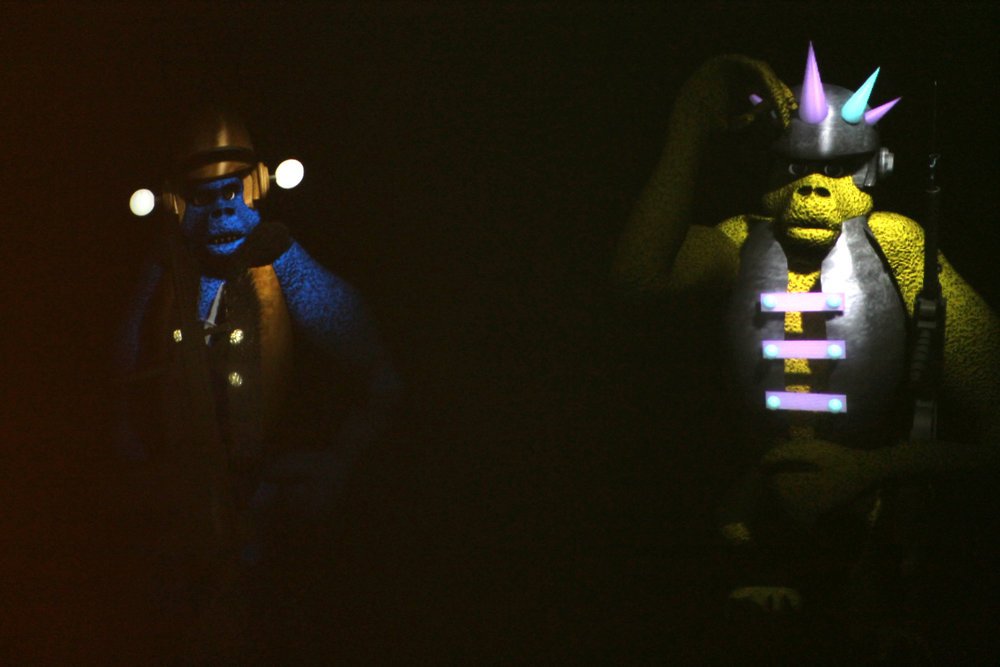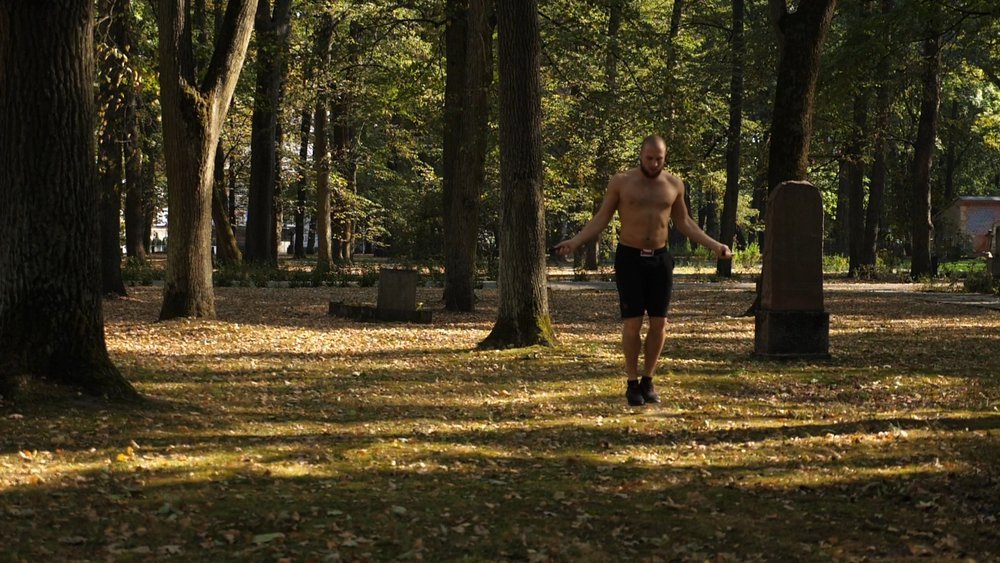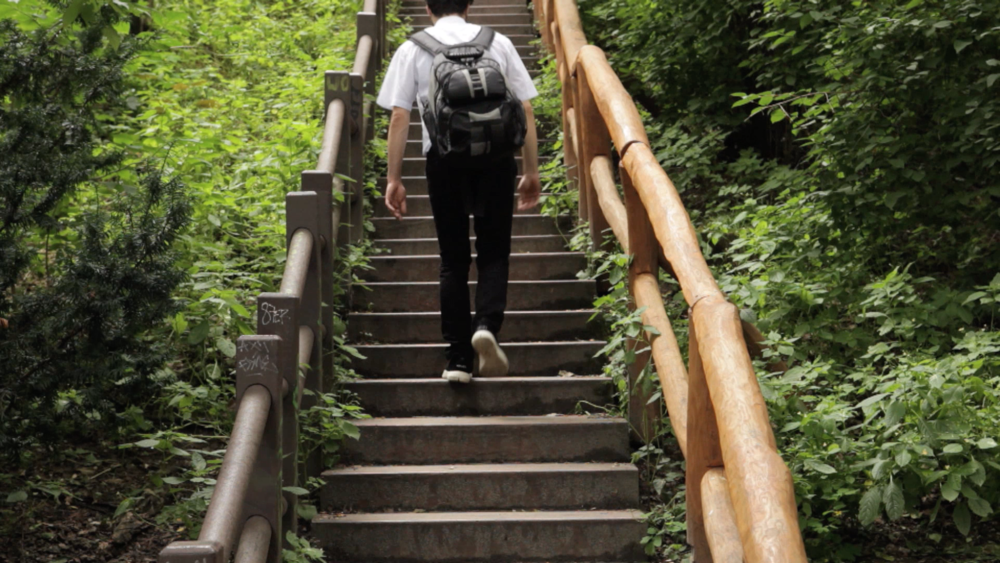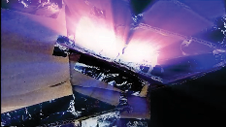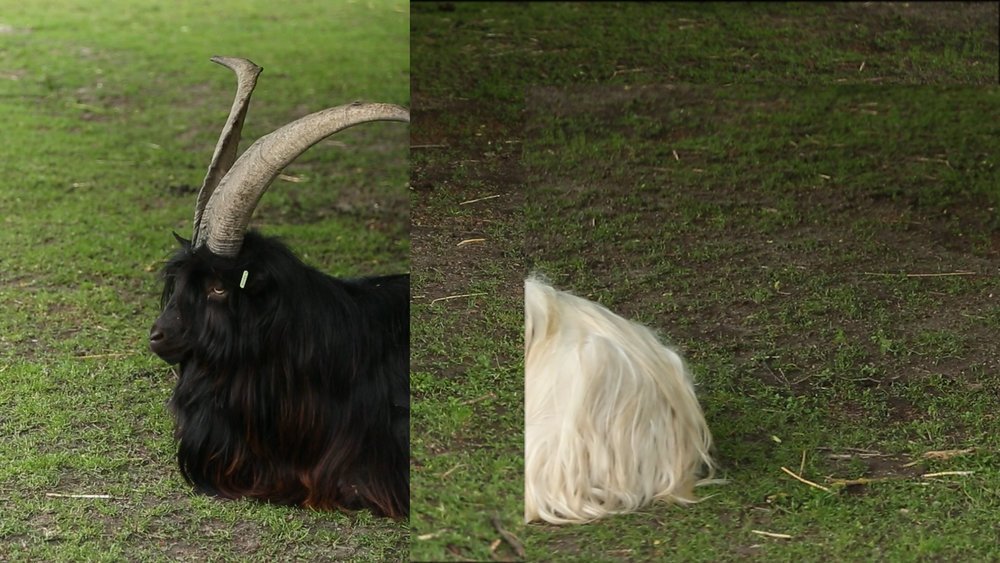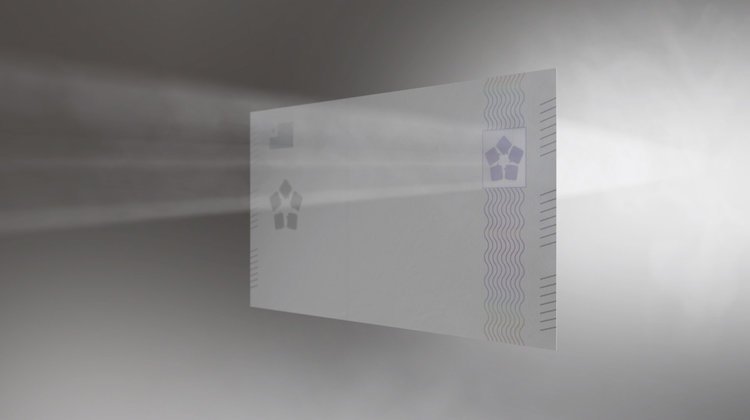
TWO CHANNEL VIDEO FESTIVAL
January 6–February 1, 2019
Skowhegan is excited to announce its first ever Two Channel Video Festival, which takes place between January 6, 2019–February 1, 2019.
Almost three years ago, the Skowhegan Alliance identified the lack of opportunities to exhibit multi-channel video works. It is a hard medium to accommodate: two-channel works are never fully realized in a traditional film screening, but a proper installation can require a skillset ranging from programming to pipe sawing.
After an immeasurable amount of dedication, labor, and optimism from the project’s organizer Gregory Kalliche (A ’15), advising from other Alliance members, critical support from staff Chris Carroll (A ’08), and patience from the participating artists, we have something to show you: four weeks of two-channel video art, in three different configurations, from 23 artists.
WEEK 1: CORNER
Sunday, January 6 - Friday, January 11
Jaye Rhee (A '09), Polka Dots
Ana María Gómez López (A '15), On Taphonomy
Mary Vettise (A '12), A reality with forms
Lorena Mal (A '16), Invisible Structures
Jonathan Ehrenberg (A '11), Monument
Jaye Rhee (A'09), Polka Dots, 2017
Jaye Rhee (A ’09 )
Polka Dots, 02:22
2017
In the 1970s in Korea, imagery associated with the Baby Boom generation became massively popular through advertising, and some of the most frequently used images in ads aimed at women were polka-dotted patterns. As a result, polka-dotted fabrics and clothing came to connote domesticity. In the video “Polka Dots,” I attempted to both evoke and arose their associated significations simultaneously by reconfiguring polka dots in uncustomary ways. This work was made possible, in part, by the Franklin Furnace Fund supported by the Lambent Foundation Fund of Tides Foundation; and Jerome Foundation. Jaye Rhee has exhibited at the Albright-Knox Art Gallery, the Norton Museum of Art, the High Museum of Art, the Queens Museum, the Bronx Museum of the Arts, the Mori Art Museum (Tokyo), the Leeum Samsung Museum, the Seoul Museum of Art, and the Center for Art and Architecture Affairs in Portugal. Her residencies include the Defina Foundation in London (2018), the Skowhegan School of Painting and Sculpture in Main (2009), the Palais de Tokyo Workshop Program in Paris (2009), and the Chandong International Studio Program in Seoul (2008). She lives and works in New York.
Ana María Gómez López (A ’15), On Taphonomy, 2017
Ana María Gómez López (A ’15)
On Taphonomy, 08:00
2017
On Taphonomy is a video installation about the origin of the scientific discipline that examines what happens to organisms after death, from decay through to fossilization. Taphonomy was pioneered in part by Johannes Weigelt, a German paleontologist who was affiliated with the Nazi party during the Second World War. On Taphonomy delves into Weigelt’s copious photographic documentation of animal carcasses and fossil specimens, juxtaposing these records with his personal Dada-inspired collages. Here, the fossil meets the photographic negative: remnants of prehistoric epochs commingle with snapshots of a more recent past. Stratigraphic layers and visual imprints, both mineral and film-based, peer through Weigelt’s montage techniques. And taphonomy emerges as a reflective dimension of these ancient and scholarly vestiges—a means to interpret geological and ideological traces in the fossil record and the private archive alike.
Mary Vettise (A ’12), A reality with forms, 2014
Mary Vettise (A ’12)
A reality with forms, 05:54
2014
A reality with forms is constructed from two SketchUp 3-d models made by the same anonymous user and freely available from 3D Warehouse. The amateur CAD models, one of the HMS Titanic and one of the palace of Versailles, are fan-art type depictions that draw from popular culture rather than historical accuracy. The models are detailed, but also full of quirks and imperfections, so that when animated the 3-dimensional space breaks down. One channel of the work re-animates the Titanic making reference to the 1997 film, famed for its special effects budget, and the other channel reanimates the palace of Versailles, with reference to the 1962 film, Last Year at Marienbad, known for its cryptic plot and dreamlike sequences. These contrasting examples of cinema are referenced side-by-side that pays homage to the anonymous creator and to the notion of fan-art. The phrase, ‘A reality with forms’, is the definition of cinema given by Last Year at Marienbad scriptwriter Alain RobbeGrillet. Mary Vettise is an artist based in Berlin. She studied at Camberwell College of Arts and the Slade School of Fine Art, London. Exhibitions include: The Shift, Flat Time House, 2016; I Never Lied To You, Camberwell Space, London, 2015; A reality with forms (solo), Oriel Davies, Newtown, Wales, 2014. Performances and screenings include: No Screening, ICA, London, 2016; ReRecord 6, Prototyp, Prague, 2016; Cinema6, Arcadia Missa, London, 2014.
Lorena Mal (A ’16), Invisible Structures, 2010-12
Lorena Mal (A ’16)
Invisible Structures, 06:40 (variable)
2010-12
Invisible Structures is a drawing series that gathers personal maps of lived spaces of different geographies and experienced in different languages. As the spaces are made visible through drawing lines made frame by frame following every hand movement of a person’s description, the dialogue between each is not established by word’s meaning nor common architecture but by the silent body that trace similitudes, differences, and common limits with its gestures. Lorena Mal (n. 1986, Mexico City) is an artist from Mexico city whose work combines mediums such as sound, video, sculpture and performance, focusing on sound and visibility as tools of investigation to question systems of knowledge that are the foundations of lineal and authoritarian perceptions of political and historical narratives. Recent solo exhibitions are ‘Replicas: Notes on material history’, Museo ExTeresa, Mexico city 2017- 2018; ‘Concrete: turning something invisible into matter’, Meinblau, Berlin 2016; and ‘Breaking Point’, BB15, Linz 2016. Her work has been exhibited in venues as Armory Center for the Arts, California; FOFA Gallery, Montreal; Laboratorio Arte Alameda, Mexico city; Lakeeren Gallery, Mumbai; Jumex Foundation/Collection, Ecatepec; Institute of Graphic Arts, Oaxaca, among many others.
Jonathan Ehrenberg (A ’11), Monument, 2010
Jonathan Ehrenberg (A ’11)
Monument, 01:03 (originally looped)
2010
In Monument, which was created with in-camera effects, the line between inside and outside gives way as houses unfold into landscapes or float to the horizon. Jonathan Ehrenberg’s work explores how we experience reality as a construct, a seemingly coherent world we piece together from sensory information and images we see internally—memories, fantasies, and associations. Ehrenberg received a BA from Brown University, and an MFA from Yale. His work has been included in exhibitions at MoMA PS1, SculptureCenter, Nicelle Beauchene Gallery (New York), LAXART (Los Angeles), David Castillo (Miami), Futura Center (Prague), The B3 Biennial (Frankfurt), Espacio Minimo (Madrid), Temnikova & Kasela (Tallinn), and Nara Roesler (São Paulo). His work has been reviewed in The New York Times, The New Yorker, and Art in America, and he has participated in residencies at LMCC Workspace, Harvestworks, Skowhegan, Triangle, the Fine Arts Work Center in Provincetown, The Drawing Center, and Glenfiddich in Scotland.
WEEK 2: FACING
Monday, January 14 - Friday, January 18
Elizabeth M. Webb (A '18), CONVERSE, CONVERSE
James R Southard (A '12), Father's Flag Part A & B
Tricia McLaughlin (A '92), Disposable Heroes
Josefina Malmegård (A '16), Heavenly bodies.
Jessica Segall (A '10), (un)common intimacy
Sharon Paz (A '01), HOMESICK
Elizabeth M. Webb (A ’18)
CONVERSE, CONVERSE
Converse, Converse is a two-channel video installation that creates a virtual conversation between family members who have never met. At age 18, I discovered a family history that had gone unspoken for a generation: my father’s father, whom I never met, was African-American—my father had been passing as white. He had also decided to raise our family as such, giving us no knowledge of our black ancestry. I have since connected with that side of my family and spoken with my father about his decision. Through a process of recording conversations with my father and separate conversations with the women I learned were my second cousins, I positioned myself as a go-between, filming each side watching the other’s interviews and finally, the reactions to their respective reactions. The viewer is situated between two parallel projection walls such that both sides of the conversation can never be viewed simultaneously—the viewer must choose a side. However, all the sound, from the conversations to the reactions, can be heard at all times. The act of choosing and the intimacy of listening implicates the viewer in the projected family drama.
James R. Southard (A ’12), Father’s Flag Part A & B
James R. Southard (A ’12)
Father’s Flag Part A & B
This is a dual video installation. Both are to be shown in the same space opposite each other. They are to play in a constant loop at the same time. Sound from both videos are to be at equal volume.
Over the years I’ve been looking into artwork that addressed how I saw my own community and culture. Being from the American Southeast, I wasn’t interested in how the world saw my culture, but how other southerners saw themselves. There are a million different ways to approach the subject of how a culture sees itself, but I have been making attempts to question how our culture picks and chooses its own aesthetic and ethos. I knew that we portrayed ourselves uniquely, yet many things that make the American South so distinct can easily be found elsewhere. So I believe we seek to distinguish our characteristics so that we can still keep an aura of societal independence. It is this act of looking inward, reflecting and creating an identity that I find more interesting and I have been finding ways to discuss it in my artwork.
This video installation is one of them. I came across the confederate flag shown in the video among my father’s belongings and I looked at the reasons why he owned and kept it. The symbol of the flag has many historical and abject connotations; yet dealing with the object is harder than I could of imagined. I wanted to address my father’s flag in the most honest method possible. Before I retired his flag, I waved it in the manner that I deemed fitting. The truck doing donuts, tearing at the earth, deals with the adolescent act of showing off and not seriously understanding our own acting’s. Living for the moment can be liberating, but I also wanted to address the history of this symbol aside from this object’s personal connection to me. So laying the flag to rest in a flag retirement ceremony seemed to be the best way to finish the cycle of this object’s life.
After receiving his MFA from Carnegie Mellon in 2011, James Robert Southard has worked in the art world through invitations to international exhibitions such as the Moscow Biennale for Young Art, Hel’Pitts’Sinki’Burgh in Finland, Camaguey Cuba’s 5th International Video Art Fest and participation in the Internet Pavilion at the 54th Venice Biennale in Venice Italy. In 2012, James started a collaborative photography and video series with the collaboration of the city of Seoul, Korea at Seoul Art Space Geumcheon. Soon after he took his project to Maine where he was a participant at Skowhegan School of Painting and Sculpture, then later to MacDowell Colony in New Hampshire, Yaddo Retreat in New York, Jentel in Wyoming, MASS MoCA and currently to the dairy farmers of northern Vermont. His digital construction process allows for public interactions and collaborations to combine together in the aesthetics of each composition. While continuing this process in new communities, He has also returned to academia by teaching photography at the University of Kentucky.
Tricia McLaughlin (A ’92), Disposable Heroes
Tricia McLaughlin (A ’92)
Disposable Heroes
Inspired by Anarchist and peace activist Emma Goldman’s speech “Patriotism: A Menace to Liberty”, artist Tricia McLaughlin manifests a multimedia world of ruling and warring apes. The animations become a war zone of ideas emanating from the actual words of the renowned activist spoken in various tongues: English, Spanish, Korean, Arabic, Polish, Hebrew, Wolof, and others.
For Emma Goldman "War is a quarrel between two thieves too cowardly to fight their own battle. Therefore, they take boys from one village and another village, stick them into uniforms, equip them with guns, and let them loose like wild beasts against each other."
For Tricia McLaughlin Disposable Heroes continues her exploration of the human need to impose order and design upon the world: “In some ways my approach to art borrows from Goldman’s spirit of anarchy. The status quo isn’t always the best rule. The social constructs we live by affect our behavior. Modifying, or exaggerating those constructs and rules, changes the game. More so when it is a game of power.”
Josefina Malmegård (A ’16), Heavenly bodies
Josefina Malmegård (A ’16)
Heavenly bodies
Heavenly Bodies is a two-channel video installation where one of the videos shows the interaction between two fitness enthusiasts. We follow their communication and training which sometimes questions the iconic image of the strong, independent man. Through selfies and motivational texts, they build their personal brands on social media. To subvert the normative image of training in the gym, the bodybuilders are filmed in natural landscapes. Surrounded by greenery, their bodies may be read in light of ritual and holy practices. The monologue is based upon text from one of the protagonist’s Instagram accounts.
The second video shows a martial art champion’s training with a rope at a cemetery in autumn. This video reflects upon bodies as perishable matter.
Through Instagram I have come in contact with bodybuilders, MMA professionals and fitness enthusiasts. Their profiles show pictures and text which present their philosophy that everything is possible; you can be “fit”, and “improve” yourself through physical training. The aim is to create “the best version of themselves”. Reminiscent of religious communities, their path is marked by discipline and dedication.
Jessica Segall (A ’10), (un)common intimacy
Jessica Segall (A ’10)
(un)common intimacy
Today in the United States, there is an onus on volunteers to pick up environmental responsibility that was once upheld by civic organizations. Free-market environmentalists assume a self-prescribed role of rouge animal guardian. Private wildcat reserves create an ecological diversity of fauna never coexistent under one biome, based on selective and desired organisms, namely that of a pre-colonial past. Here, tigers and lions roam a mowed landscape of the American South. These preserved wilderness sites reinforce ideals of private property, producing capital from both the conservation and entertainment economies. Un-common Intimacy was shot in private wildlife reserves in the six states that allow private ownership of large predators. I trained to handle the wildlife in order to embed myself in the ready-made sites.
Sharon Paz (A ’01), HOMESICK
Sharon Paz (A ’01)
HOMESICK
HOMESICK is inspired by the short story The Kitchen Clock by the German writer and playwright Wolfgang Borchert, who is considered part of the so-called Trümmerliteratur (rubble literature) of post-war Germany. The specific short story deals with a young man who lost his home and his parents during a bomb attack. Still today, the short story stands for situations in which people lose everything, have to start from scratch and rebuild their lives.
The video was shot at "Volkspark Humboldthain" in Berlin-Mitte, which was built in 1869. In the years 1941/1942, a complex high bunker with two flaked towers, heavily contested towards the end of the Second World War, was erected. After World War II, the bunker and towers were blasted, covered with rubble into an artificial mountain. Today the upper top plate of the former tower serves as an official vantage point, and a part of the bunker system can be visited again.
Homesick puts the war-torn story of the district in relation to the current situation in the Mediterranean and shows how stories of flight and expulsion, reconstruction and new beginnings recur and interfere.
WEEK 3: SIDE BY SIDE
Monday, January 21 - Friday, January 25
Itziar Barrio (A '12), Mirroring Basic Instinct
Alan Segal (A '15), Internacia Lingvo
Shana Hoehn (A '13), Boggy Creek Version 2
Seline Baumgartner (A '14), Nothing Else
Bryan Zanisnik (A '08), Aquarium Painting
Lex Brown (A '12), Projection Affection
Cooper Holoweski (A '09), As Above, So Below
Itziar Barrio (A ’12)
Mirroring Basic Instinct
Barrio appropriates an infamous scene from the film Basic Instinct (1992) Dir. Paul Verhoeven. Rather than a panty-less Sharon Stone, however, Barrio’s actors are both clothed and male. Reciting Stone’s lines they call attention to the artifice and mechanisms of all production (as well as the ways in which it is always inflected by gender, race, and class). Both performers, who we also see performing the police and the thief in 'All Of Us Want To Work Less', repeat gestures and lines of the scene. Sometimes they are synched and sometimes they are not, referring to the learning process and ideas of the otherness. This piece is part of the multimedia project 'All Of Us Want To Work Less' (2014 - 2018). Like many of Barrio’s projects, this takes multiple elements and forms (performance, video, and sculptures) and is ongoing. At stake in its distinct iterations are questions revolving around labor and the value of different kinds of work. In a performance executed in 2015 at MACBA Museum Barrio appropriates the infamous scene from Basic Instinct. Barrio’s actor broke from the original script by engaging in producing a cement sculpture that hardens during the rest of his performance. In a 2016 video also titled 'All of Us Want To Work Less', two actors riff off Robert Bresson’s 1959 feature film, Pickpocket. It explores the relationship between work and legality, while queering the space of 'criminality' the original movie implies. A pointed critique of labor policies and conditions, Barrio’s piece ironically shows that even stealing requires a precise skill-set and lots of practice if one is to succeed at it.
Alan Segal (A ’15)
Internacia Lingvo
In the late 90s, the euro was introduced as a replacement for local European currencies, carrying with it the promise of economic integration through a single currency and the desire for a more self-regulated market. One hundred years prior, Ludwik Lejzer Zamenhof had a similarly utopic aim when he invented an artificial language called Esperanto. This language was constructed from a multicultural buffet of sounds, rules, and access points.
The failures of these two administrative projects have been collapsed into a single object. They are antithetical faces of global manifestos that converge in the minefield of the nationalistic present.
Shana Hoehn (A ’13)
Boggy Creek Version 2
Boggy Creek version2 is based on popular culture and mythology surrounding monster sightings along the Texas-Arkansas border where the Hoehn grew up. With the aid of anamorphic illusions, often used throughout art history to camouflage erotic images and dangerous political statements, Hoehn conflates “the real” as it is manifested in folklore, social constructions, and digital manipulations in the video’s images and props. In the video, Hoehn straps a crystal boat on top of her car and heads to Boggy Creek. Affixed to her boat is an angry mermaid figurehead. At home, she pumps gas at Monster Mart, a convenience store featuring a large sculpture of the Fouke Monster. The monster and mermaid, both imagined as male-explorer fantasies, meet. As the video progresses, Hoehn travels waterways searching for the creatures, seeking solidarity with their in their incarnated forms.
Seline Baumgartner (A ’14)
Nothing Else
Collaboration with the dancers: Meg Harper, Jon Kinzel, Vicky Shick, Keith Sabado
“NOTHING ELSE ”, is an EMPAC DANCE MOViES Commission 2013 - 2014, supported by The Jaffe Fund for Experimental Media and Performing Arts. Experimental Media and Performing Arts Center (EMPAC), Rensselaer Polytechnic Institute, Troy, NY”
“You don’t see Baumgartner in her art, at least not directly: you see instead her steady gaze, those warm eyes open and trained on others. In her recent videos Seline Baumgartner has been collaborating with New York dance royalty: Sally Gross, Meg Harper, Jon Kinzel, Keith Sabado, Vicky Shick and Robert Swinston. None of these performers are young, a fact that has been made much of in most of the writing about this body of work. But this fact is almost entirely uninteresting, really, other than what it reveals about tedious Western expectations around bodies. The real point here isn’t age, but experience, and how it deepens artistry. Small, subtle shifts of weight, of gaze, of intensity, these all take on outsize implications—the point is never what these individuals do, but how. Baumgartner gives the space for these implications to ripple out, overlap, interrupt…creating the most satisfying sort of portrait, the non-narrative one.
There are many complicated intellectual scaffolds one can erect around the intersection between camera and body. But there are also wordless pleasures. All that the doer does. All that the seer perceives. This is something besides. The way time moves, catches, redirects. The frame is full; and then it is empty.”
- Excerpt from a text by Claudia La Rocco
Bryan Zanisnik (A ’08)
Aquarium Painting
Using discarded walls from a hospital, I constructed a maze-like labyrinth at a recycling center in Philadelphia. Each room is populated with objects sourced from the dump; one room suggests a bar, the next a 99-cent shop. As my father tours the structure he constructs fictitious narratives about the objects before him. As the labyrinth shifts from the domestic, to the commercial, to the industrial, the incongruent narrative raises questions on the psychological and historical meaning of objects.
Lex Brown (A ’12)
Projection Affection
An early work; attempting to become one with color and the tools of projection.
Lex Brown is an artist, musician, and writer. Her work plays with the scale of personal and emotional experience in relation to large scale systems of social and economic organization. She has performed and exhibited work at the the New Museum, the High Line, the International Center of Photography, and Deli Gallery in New York; REDCAT Theater and The Hammer Museum in Los Angeles; and at the Munch Museum in Oslo, Norway. Brown holds degrees from Yale University (MFA) and Princeton University (BA). Her first paperback work in fiction, My Wet Hot Drone Summer, a sci-fi erotic novella that takes on surveillance and social justice, is available online. This April she will be a resident artist at Recess Sessions in Brooklyn. Her first institutional solo show Animal Static is currently on view at The Kitchen until February 23.
Cooper Holoweski (A ’09)
As Above, So Below
As Above, So Below is a two-channel HD video installation with sound that uses everyday objects to depict parallels between the cosmic and subatomic realms. Inspired by the 1977 Eames Film “Powers of Ten” the piece also draws from the notion of macrocosm/microcosm as originated by the 16th century theologian Robert Fludd. Macrocosm and microcosm are terms from religious esotericism that refer to a vision of the cosmos reflected within a smaller part of itself.
As Above, So Below illustrates the concept with materials such as aluminum foil, coffee grounds, and Styrofoam to draw parallels between micro and macro – the commonplace and the divine.
WEEK 4: SIDE BY SIDE
Monday January 28 - Friday February 1
Richard T. Walker (A ’09), the predicament of always (as it is)
Kerry Downey (A ’17) and Joanna Seitz, Weather Report
Angela Willetts (A ’16), Escape Raft
Orr Menirom (A ’16), Clinton and Sanders Looking at the World and Naming Things for the First Time
Holli McEntegart (A ’14), Beyond the ultraviolet, beyond the infrared
Jennifer Calivas (A ’16) and Dan Swindel, Sides
Richard T. Walker (A ’09)
the predicament of always (as it is)
Alone in a desert landscape the artist is depicted talking into a cassette recorder. Everything is silent but the recorded audio that is played back in sync with the video. Within this slippage of time the recorded voice describes uncertainties and doubts about his position within the whole. The landscape changes and rocks are thrown at instruments that have been placed within these spaces, creating a sonic component that is edited together to produce a collage of haphazard instrumentation. As rocks hit their targets different tones emanate to form notes, chords and rhythm. The result is a progressive catalogue of sounds that unite to create a sense of meaning through musical composition, reviewing and remixing the fluid experience of being within these vast landscapes. The video was filmed throughout the deserts of the South Western USA.
Selected solo exhibitions include; FraenkelLAB, San Francisco, Hiroshima City Museum of Contemporary Art, Japan; di Rosa, Napa, California; The Contemporary Austin; ASU Museum, Tempe, Arizona; James Cohan Gallery, New York; Carroll/Fletcher, London; Angels Barcelona; Spike Island, Bristol; and Franklin Art Works, Minneapolis.
Group and two person exhibitions include; CAPITAL, San Francisco; San Francisco Museum of Modern Art; Yerba Buena Center for the Arts; Times Museum, Guangzhou; Museum of Modern Art, Rio De jenero; Kulturhuset Stockholm; Witte De With Rotterdam and K21 in Dusseldorf.
He was recently awarded a Eureka Fellowship and has been a recipient of the fellowship at Kala Art Institute in Berkeley and received an Artadia Award in 2009. He was an Irvine Fellow at the Montalvo Art Center and has been a resident at The Headlands Center for the Arts.
Courtesy of the artist and Fraenkel Gallery.
Kerry Downey (A ’17 ) and Joanna Seitz
Weather Report
In Weather Report (2018), Kerry Downey and Joanna Seitz balance landscape and portraiture through the video’s two channels. A natural shoreline, infused with the ethereal plumes of artificially colored smoke, meets a diminutive white cube, in which the artists navigate the relation between their bodies and the physical surround. Entanglements of the body and the environment, the object and the subject, manifest in Seitz and Downey’s movement, revealing relations of mutual care, interdependence and shared process through measured choreography.
Orr Menirom (A ’16)
Clinton and Sanders Looking at the World and Naming Things for the First Time
This video is based on a CNN debate which took place in 2016 between the democratic presidential candidates. The visuals of the debate had been removed and replaced alternative footage. The words of the politicians, carved out of the crafted speeches, are used to describe plants, animals and natural phenomena. The candidates’ voices distort into a digital, robotic dialog, turning the debate into a Rorschach test onto which viewers can project their own thoughts and associations.
One of the influences on this poem is machine a machine learning technology called DeepDream. This is a software designed in 2014 to identify and classify visual patterns. I began researching the influence of technology on cognitive and political perception during the 2016 election campaign. The brain’s tendency to look for meaning and patterns is stronger when there is a feeling of a lack of control—for example, at times of political change and uncertainty. Are we, like an algorithm, trapped in mind patterns that prevent us from perceiving reality as it is? This video tries to imagine what it would mean to see the world freed from those patterns we have acquired.
Holli McEntegart (A ’14)
Beyond the ultraviolet, beyond the infrared
Beyond the ultraviolet, beyond the infrared is a two channel video that documents an eight week durational performance leaving energy residue. This site was located and demarcated by myself and Natalie Haggar; Treasurer of the New Zealand Foundation of Spiritualists Mediums. We worked with the energies already present in the gallery, seeking to identify and bring forth both positive and negative energy aspects, to pinpoint the optimum space for this project to inhabit. Once the site was identified and marked out, Natalie cleared any lingering negative energy and tasked me with the job of keeping it that way for the next eight weeks. This process marked the beginning of the performance and initiated an organic and spontaneous series of thirteen events documented both via video and in a risograph printed text document. The video was shot and edited in real time as each happening unfolded in the demarcated space and then installed back into the space.
Jennifer Calivas (A ’16) and Dan Swindel
Sides
Sides is Calivas and Swindel’s first collaboration. In the video they play characters who seem to operate empathetically and mimetically, connected through speech and movement - ultimately however, they always fall short of becoming fully synchronized. As they move through different locations, the two interact against a backdrop of ecological collapse.







